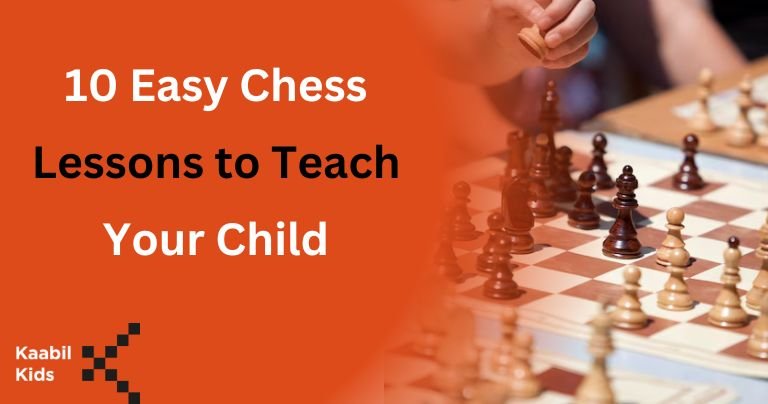Chess is a game that entertains us while sharpening the mind, improving concentration, and enhancing problem-solving skills.
Teaching your child chess can be a rewarding experience, especially when using simple and engaging lessons.
After mastering the fundamentals, the child can resume playing the game, just as learning to swim or ride a bike leaves a lasting impression on the mind.
Whether you’re a parent, teacher, or chess enthusiast, these ten easy chess lessons will help you guide your child through the basics of the game.
Learning chess for beginners online has always been challenging, thanks to the availability of beginner-friendly online chess programs.
Kaabil Kids has some excellent materials for online chess for beginners making the game enjoyable and interactive.
Introduce the Chess Pieces
The first step in teaching chess is introducing your child to the chess pieces. Each piece has its unique movement and role on the board. Start by introducing the six different pieces: King, Queen, Rook, Bishop, Knight, and Pawn. Explain how each piece moves:
- King: Moves one square in any direction.
- Queen: Turns any number of squares in any direction.
- Rook: Turns any number of squares horizontally or vertically.
- Bishop: Moves any number of squares diagonally.
- Knight: Turns in an L-shape (two squares in one direction and one square perpendicular).
- Pawn: Moves one square forward, with an option to move two squares forward on its first move, and captures diagonally.
By understanding these movements, your child can start to see how each piece contributes to the game. Use visual aids or online chess games. This will make learning chess for beginners online easy.
Setting Up the Chessboard
The next lesson involves setting up the chessboard correctly. The chessboard consists of 64 squares, alternately light and dark. Explain to your child that the board should be placed so that a white square is on their right-hand side.
Teach them to place the pieces in their correct starting positions:
- Pawns: In the second row.
- Rooks: In the corners.
- Knights: Next to the rooks.
- Bishops: Next to the knights.
- Queen: On her colour (Both a black queen and a white queen are displayed on separate squares).
- King: Beside the queen on the closing square.
This step helps your child to understand the game structure. We offer interactive tools to help children practice setting up the board, making it easier to learn chess online.
Basic Rules and Objectives
Before playing, it’s crucial to teach your child the basic rules and objectives of chess. Explain that the goal of chess is to checkmate the king of the other team. It happens when the king is in a position to be captured (“in check”) and cannot escape.
Here are some essential rules to cover:
- Turns: Players take turns moving one piece.
- Capture: Pieces are captured by landing on a square occupied by an opponent’s piece.
- Check: A king is in check when he is in danger of capture.
- Checkmate: The game ends in checkmate when the king cannot escape a check.
By understanding these rules, your child will be ready to play their first complete game of chess. Online chess for beginners often includes tutorials on these basic concepts, making it easier for children to grasp the rules.
The Importance of Pawn Structure
Pawns may seem insignificant, but they play a critical role in the game. Teach your child about pawn structure and how it can impact the flow of the game. Explain concepts like:
- Pawn Chains: A diagonal line of pawns protecting each other.
- Passed Pawns: Pawns that have no opposing pawns on their road to promotion.
- Isolated Pawns: Pawns that have no friendly pawns on nearby files.
Understanding pawn structure helps children see the strategic depth of chess. Kaabil Kids provides resources that explain these concepts in a child-friendly manner, helping them learn chess online at their own pace.
Understanding Piece Coordination
Chess is more than about moving individual pieces. It’s about coordinating them to work together. Teach your child how to develop their pieces and create strong formations. Key points to cover include:
- Central Control: Dominating the centre of the board with pawns and pieces.
- Piece Development: Moving pieces off their starting squares to active positions.
- King Safety: Protecting the king by castling.
Focusing on piece coordination will help your child build a strong position and prepare for tactical opportunities. Chess classes online for kids often emphasize these principles and provide exercises to practice piece coordination.
Tactics and Combinations
Tactics are the short-term calculations that lead to immediate advantages, such as winning material or delivering checkmate. Introduce your child to basic tactics like:
- Forks: Attacking two or more pieces simultaneously with one piece.
- Pins: Restricting a piece’s movement because moving it would expose a more valuable piece.
- Skewers: Forcing a piece to move and reveal another piece behind it.
- Discovered Attack: Move one piece to reveal another piece’s harm.
These tactical patterns are essential for success in chess. Encourage your child to practice these tactics through puzzles and games. Kaabil Kids offers interactive lessons that make learning chess for beginners engaging and fun.
The Opening Principles
In the opening, where players establish their pieces and fight for control of the board. Teach your child the basic principles of opening play:
- Control the Center: Use pawns and pieces to dominate the central squares.
- Develop Your Pieces: Move knights and bishops to active positions.
- King Safety: Castle early to protect your king.
- Avoid Moving the Same Piece Twice: Develop all your pieces before moving the same piece again.
Understanding these principles will give your child a solid foundation for starting the game. Online chess for beginners often includes tutorials on popular opening strategies, which can be an excellent way for your child to learn chess online.
Endgame Fundamentals
The endgame is the final phase of the game, when a few pieces are left on the board. Teach your child the basics of endgame strategy, including:
- King Activity: The king becomes an influential piece in the endgame, so encourage your child to use it actively.
- Pawn Promotion: Advancing pawns to promote them to queens.
- Basic Checkmates: Play basic checkmates, like king and queen vs king and king vs rook.
By learning these endgame fundamentals, your child will be better prepared to finish games successfully. Chess classes online for kids often include endgame training, helping children build confidence in this critical phase of the game.
Chess Etiquette and Sportsmanship
Chess is not just about winning; it’s also about playing with respect and good sportsmanship. Teach your child the importance of:
- Shaking Hands: Before and after the game, as a sign of respect.
- Respecting Opponents: Treating opponents with courtesy, regardless of the game’s outcome.
- Learning from Losses: Viewing losses as opportunities to learn and improve.
These lessons in etiquette are essential for developing a well-rounded chess player. Kaabil Kids emphasizes the importance of sportsmanship in their chess classes online for kids, promoting a positive learning environment.
Practice and Play
The final lesson is the most important: practice and play regularly. Encourage your child to play chess, whether it’s with family, friends, or online opponents. The more they play, the more they’ll internalize the lessons and strategies they’ve learned.
We offer a variety of online chess for beginners, including interactive games, puzzles, and challenges. These resources provide a fun and engaging way for children to practice and improve their skills.
Conclusion
Teaching your child to play chess is a journey that can bring lifelong benefits. By following these ten easy lessons, you’ll help them build a strong foundation in the game.
Whether you’re using online chess for beginners or enrolling them in chess classes online for kids, Kaabil Kids provides the tools and resources needed to make learning chess for beginners an enjoyable experience.
With patience, practice, and encouragement, your child will soon be navigating the chessboard with confidence and skill.


